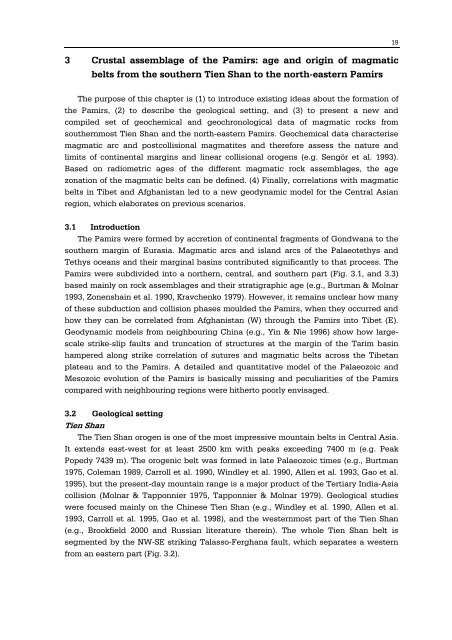tübinger geowissenschaftliche arbeiten (tga) - TOBIAS-lib ...
tübinger geowissenschaftliche arbeiten (tga) - TOBIAS-lib ...
tübinger geowissenschaftliche arbeiten (tga) - TOBIAS-lib ...
You also want an ePaper? Increase the reach of your titles
YUMPU automatically turns print PDFs into web optimized ePapers that Google loves.
3 Crustal assemblage of the Pamirs: age and origin of magmatic<br />
belts from the southern Tien Shan to the north-eastern Pamirs<br />
The purpose of this chapter is (1) to introduce existing ideas about the formation of<br />
the Pamirs, (2) to describe the geological setting, and (3) to present a new and<br />
compiled set of geochemical and geochronological data of magmatic rocks from<br />
southernmost Tien Shan and the north-eastern Pamirs. Geochemical data characterise<br />
magmatic arc and postcollisional magmatites and therefore assess the nature and<br />
limits of continental margins and linear collisional orogens (e.g. Sengör et al. 1993).<br />
Based on radiometric ages of the different magmatic rock assemblages, the age<br />
zonation of the magmatic belts can be defined. (4) Finally, correlations with magmatic<br />
belts in Tibet and Afghanistan led to a new geodynamic model for the Central Asian<br />
region, which elaborates on previous scenarios.<br />
3.1 Introduction<br />
The Pamirs were formed by accretion of continental fragments of Gondwana to the<br />
southern margin of Eurasia. Magmatic arcs and island arcs of the Palaeotethys and<br />
Tethys oceans and their marginal basins contributed significantly to that process. The<br />
Pamirs were subdivided into a northern, central, and southern part (Fig. 3.1, and 3.3)<br />
based mainly on rock assemblages and their stratigraphic age (e.g., Burtman & Molnar<br />
1993, Zonenshain et al. 1990, Kravchenko 1979). However, it remains unclear how many<br />
of these subduction and collision phases moulded the Pamirs, when they occurred and<br />
how they can be correlated from Afghanistan (W) through the Pamirs into Tibet (E).<br />
Geodynamic models from neighbouring China (e.g., Yin & Nie 1996) show how largescale<br />
strike-slip faults and truncation of structures at the margin of the Tarim basin<br />
hampered along strike correlation of sutures and magmatic belts across the Tibetan<br />
plateau and to the Pamirs. A detailed and quantitative model of the Palaeozoic and<br />
Mesozoic evolution of the Pamirs is basically missing and peculiarities of the Pamirs<br />
compared with neighbouring regions were hitherto poorly envisaged.<br />
3.2 Geological setting<br />
Tien Shan<br />
The Tien Shan orogen is one of the most impressive mountain belts in Central Asia.<br />
It extends east-west for at least 2500 km with peaks exceeding 7400 m (e.g. Peak<br />
Popedy 7439 m). The orogenic belt was formed in late Palaeozoic times (e.g., Burtman<br />
1975, Coleman 1989, Carroll et al. 1990, Windley et al. 1990, Allen et al. 1993, Gao et al.<br />
1995), but the present-day mountain range is a major product of the Tertiary India-Asia<br />
collision (Molnar & Tapponnier 1975, Tapponnier & Molnar 1979). Geological studies<br />
were focused mainly on the Chinese Tien Shan (e.g., Windley et al. 1990, Allen et al.<br />
1993, Carroll et al. 1995, Gao et al. 1998), and the westernmost part of the Tien Shan<br />
(e.g., Brookfield 2000 and Russian literature therein). The whole Tien Shan belt is<br />
segmented by the NW-SE striking Talasso-Ferghana fault, which separates a western<br />
from an eastern part (Fig. 3.2).<br />
19

















